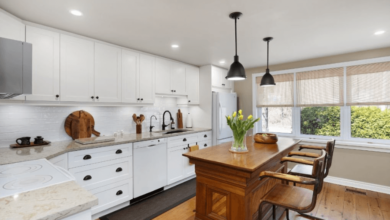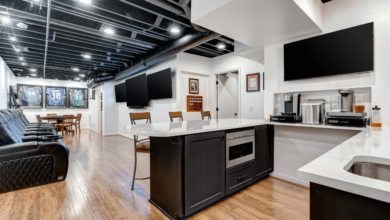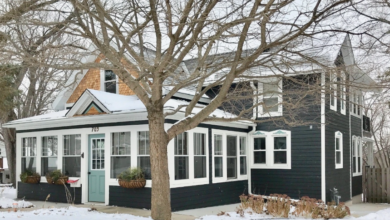Quartz Countertops: Durable and Stylish Solutions for Modern Kitchens

Quartz countertops are engineered surfaces made primarily from natural quartz combined with resins and pigments. They offer a durable, low-maintenance option that resists scratches, stains, and heat better than many natural stones. This makes quartz a practical choice for kitchens and bathrooms that require both functionality and aesthetic appeal.
Quartz countertops deliver long-lasting durability and require minimal upkeep, making them a smart investment for modern homes. Their consistent color and pattern options provide versatility that natural stone can lack, allowing for smoother design integration. Additionally, quartz is non-porous, which limits bacteria growth and simplifies cleaning.
They can be customized in thickness, edge profiles, and finishes to suit different styles and preferences. Whether used for countertops, backsplashes, or shower walls, quartz’s blend of strength and style meets the demands of busy spaces without compromising visual appeal.
Understanding Quartz Countertops
Quartz countertops combine natural minerals with engineered materials to provide durable, low-maintenance surfaces. Their production involves sophisticated processes that deliver consistent quality and aesthetic variety. Their performance and appearance differ from natural stones, influencing where they are best used in a home.
See also: Anger Management Calgary Alberta Effective Techniques and Local Support Resources
What Are Quartz Countertops
Quartz countertops are engineered surfaces composed of about 90-95% crushed natural quartz crystals. These crystals are bound together with resins, polymers, and pigments to form a solid slab.
This combination creates a non-porous, hard surface that resists staining, scratching, and heat damage better than many natural stone options. The countertop is available in a wide range of colors and patterns, some mimicking marble or granite.
Because they are man-made, quartz countertops offer uniformity in design and texture that natural stone cannot.
Manufacturing Process
Quartz slab manufacturing begins with mining high-quality quartz crystals. These are crushed into fine particles and mixed with polymers, resins, and color pigments.
The mixture is then compressed under extreme pressure and heat through a process called vibration compaction. This removes air pockets and ensures density and consistency.
Finally, the slabs cure and undergo finishing processes, including polishing to achieve a smooth, glossy surface.
The engineered nature allows manufacturers to control thickness, color, and pattern with precision.
Comparison With Natural Stone
Quartz countertops differ from natural stone such as granite and marble by being non-porous and more resistant to staining and bacteria. Unlike natural stone, quartz does not require sealing.
However, quartz is manufactured and can have less variation in pattern compared to the unique veining in natural marble or granite.
It is also generally harder and more durable, but quartz can be damaged by excessive heat, so trivets are recommended.
While natural stone ages and changes appearance over time, quartz retains its original look longer under normal use.
Popular Applications in Homes
Quartz countertops are widely used in kitchens and bathrooms due to their durability and ease of maintenance.
They fit well in high-traffic areas because of their resistance to scratches and stains.
Besides countertops, quartz surfaces are also used for backsplashes, bathroom vanities, and island tops.
Their versatility in color and pattern allows homeowners to match contemporary, traditional, or transitional styles effectively.
Quartz Countertops Maintenance and Design
Quartz countertops require specific care practices to maintain their appearance and function. Their design flexibility suits many styles, while their strong composition ensures long-term use. Understanding cost factors also helps in making informed decisions.
Cleaning and Care Tips
Quartz countertops should be cleaned regularly using a soft cloth and mild soap or a gentle, non-abrasive cleaner. Harsh chemicals, bleach, or acidic cleaners can damage the resin binding the quartz particles, so these should be avoided. Spills should be wiped up promptly to prevent potential staining, especially from substances like wine or coffee.
For tougher spots, a plastic scraper can be used carefully. Quartz is non-porous, so it doesn’t require sealing like natural stone. Avoid placing hot pots or pans directly on the surface to prevent thermal shock or discoloration.
Design Options and Finishes
Quartz countertops are available in a wide range of colors and patterns, emulating natural stones like marble and granite or showcasing modern, uniform looks. Popular finishes include polished, matte, and honed, each giving a different aesthetic and texture.
This material can also be customized in thickness, edge profiles, and integrated sink designs. Its versatility meets various design preferences, from contemporary to traditional, making it a popular choice for kitchens and bathrooms.
Durability and Longevity
The engineered nature of quartz makes it resistant to scratches, stains, and cracks under normal use. It does not chip or fade easily, and its non-porous surface helps prevent bacterial growth, contributing to a hygienic environment.
Quartz countertops typically last 15-30 years or more with proper care. While durable, they can be damaged by extreme heat or sharp impacts, so some caution is necessary to preserve their condition.
Cost Considerations
Quartz countertops generally cost more than laminate and some natural stones but less than premium granite or marble installations. Installation prices vary depending on slab thickness, edge detailing, and location.
Extra costs might include custom cutting for integrated sinks or backsplashes. The low maintenance costs and long lifespan may offset the initial investment, contributing to overall value.




